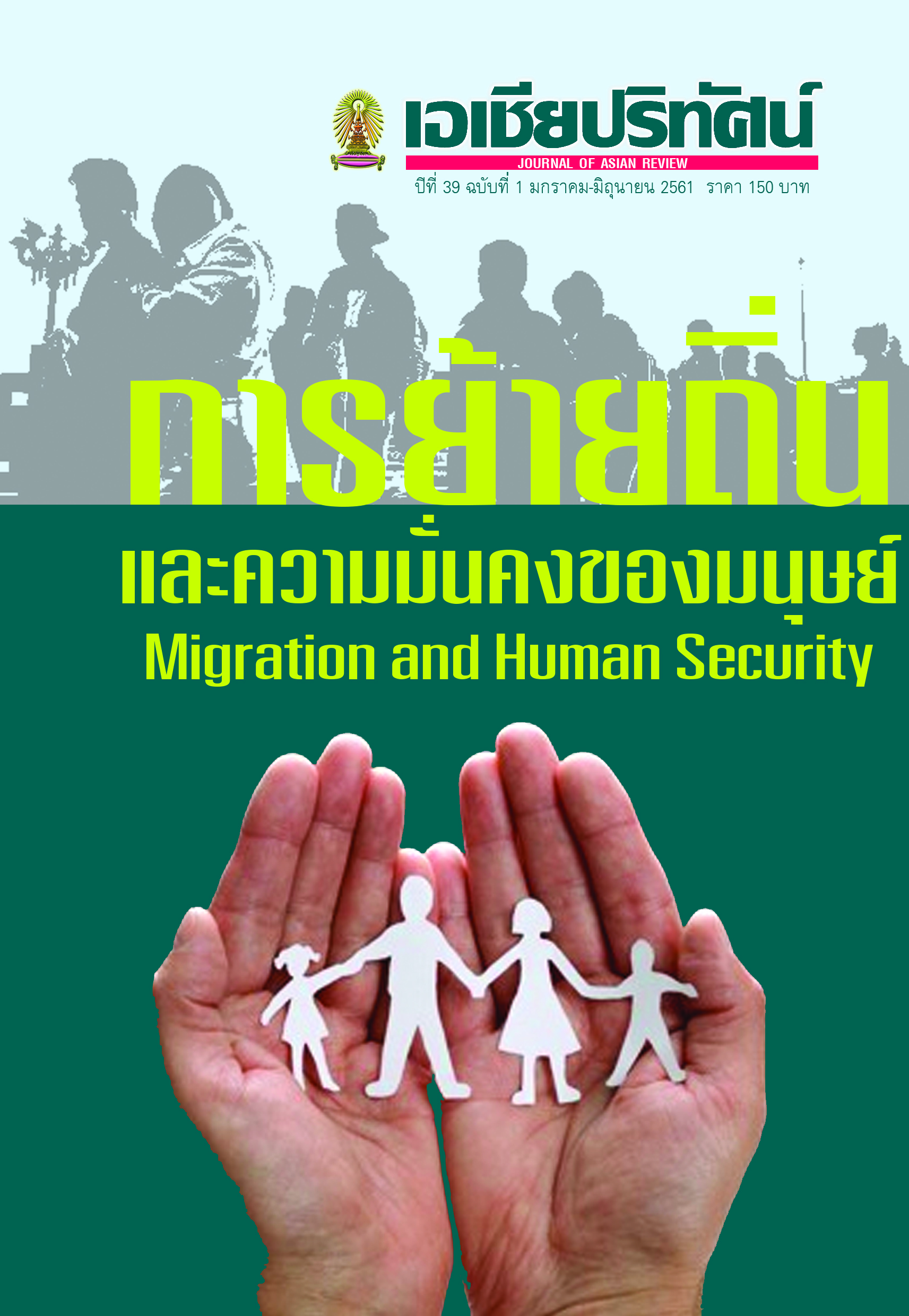Illegal Migrant Worker Public Management: Thailand Case Study
Main Article Content
Abstract
This research aims to study illegal migrant worker public management in Thailand by conducting the government documents analysis (Laws, Policies, Resolutions and Announcements). The research shows that there are 4 periods of Thai illegal migrant worker public management: The first period; the government conducted the migrant worker registration for illegal migrants (legalization), the second period; the government conducted the non-Thai identification registration for migrant workers and followers, the third period; the government conducted the worker immigration via MOUs with Laos, Cambodia and Myanmar governments, and the fourth period; the government is regulating the worker immigration according to the Emergency Decree on the Bringing of Foreigners for Working with Employers in the Country, B.E. 2559 (2016), which identifies that the private sectors are responsible for bringing migrant workers to work with them, on the other hand, the government is only responsible for the regulation. However, this practice is still not successful; there are 1,320,035 migrants being registered by the government (January 2018). These findings, consequently, lead to 2 recommendations: (1) the government should persuade related sectors to involve as a committee, together with developing a policy, a clearly strategic plan (shot, medium and long terms), an effective evaluation practice, create a co-operation network with CSOs and change the role of the government from controlling to be regulating and (2) the government should develop the policy leading the private sectors to focus on improving the capital intensive industry instead of the labour intensive industry.
Article Details
References
1. ธนาคารแห่งประเทศไทย. 2555. ภาวะเศรษฐกิจไทยปี 2554. กรุงเทพฯ: ธนาคารแห่งประเทศไทย.
2. พสุ เดชะรินทร์. 2545. เส้นทางจากกลยุทธ์สู่การปฏิบัติด้วย Balanced Scorecard และ Key Performance Indicators. กรุงเทพฯ : สำนักพิมพ์แห่งจุฬาลงกรณ์
มหาวิทยาลัย.
3. “พระราชบัญญัติการทำงานของคนต่างด้าว พ.ศ. 2551.” 2551. ราชกิจจานุเบกษา. ฉบับฎีกา เล่ม 125 ตอนที่ 37 ก.
4. “พระราชกำหนดการนำคนต่างด้าวมาทำงานกับนายจ้างในประเทศไทย พ.ศ. 2559.” 2559. ราชกิจจานุเบกษา. ฉบับฎีกา เล่ม 133 ตอนที่ 70 ก.
5. วีระศักดิ์ นาทะสิริ. 2557. “แผ่นดินของไทย ปัญหาของคนไทย (5): เรื่องแรงงานต่างด้าวในประเทศไทย.” ผู้จัดการออนไลน์, 31 กรกฏาคม. เข้าถึงเมื่อ 16 มกราคม 2560. https://mgronline.com/daily/detail/9570000086862 สมบูรณ์ ชัยรัตน์. 2543.พระราชบัญญัติจัดหางานและคุ้มครองคนหางาน พ.ศ. 2528. กรุงเทพฯ: สูตร ไพศาล.
ภาษาอังกฤษ
6. Boston, Jonathan. 1991. “The Theoretical Underpinning of Public Sector Restructuring.” In Reshaping the State: New Zealand’s Bureaucratic
Revolution, edited by Jonathan Boston, et al. Auckland: Oxford University Press.
7. Campbell, David. And Craig, Tom. 2005. Organisations and the Business Environment. 2nd edn. Burlington: Elsevier Butterworth-Heinemann.
8. Denhardt, Janet V. and Robert B. Denhardt. 2000. The New Public Service: Serving not Steering. New York: M.E. Sharpe, Inc.
9. Johnsin, C. A. 1982. MITI and The Japanese Miracle: The Growth of Industrial Policy, 1925- 1975. Stanford, Calif.: Stanford University Press.
10. Pearce II, John A., Robinson, Richard B. Jr. 2009. Strategic Management: Formulation, Implementation, and Control. 11th edn. Boston: McGraw-Hill Irwin.
11. The ASEAN Secretariat. 2017. ASEAN Economic Integration Brief No.1. Jakarta: The Community Relations Division of The ASEAN Secretariat.
12. Wade, R. 1990. Governing the Market:: economic Theory The Role of Government in East Asian Industrialization. Princeton, NJ: Princeton University Press.
13. Wheelen, Thomas L. and J. David Hunger. 2006. Strategic Management and Business Policy, 10th edn. New Jersey: Prentice Hall.
14. “Memorandum of Understanding between the Government of the Kingdom of Thailand and the Government of the Union of Myanmar
on Cooperation in the Employment of Workers.”2013. International Labour Organization (ILO), https://www.ilo.org/wcmsp5/groups/public/---asia/---ro-bangkok/documents/genericdocument/wcms_160932.pdf
15. “Memorandum of Understanding between the Government of the Kingdom of Thailand and the Government of the Kingdom of Cambodia on Cooperation in the Employment of Workers.”2013. International Labour Organization (ILO), https://www.ilo.org/wcmsp5/groups/public/---asia/---ro-bangkok/documents/genericdocument/wcms_160844.pdf
16. “MOU Between The Government of Lao People’s Democratic Republic and The Government of the Kingdom of Thailand On Labour Co-operation.” 2002. International Labour Organization (ILO), https://www.ilo.org/wcmsp5/groups/public/---asia/---ro-bangkok/documents/genericdocu ment/wcms_160929.pdf
Osbome, D. and Ted Gaebler. 1992. Reinventing Government: How the Entrepreneurial Spirit is Transforming the Public Sector. New. York: Addison-Wesley
17. Vans, Peter.1995. Embedded Automomy: States and Industrial Transformation. Princeton, NJ: Princeton University Press.


